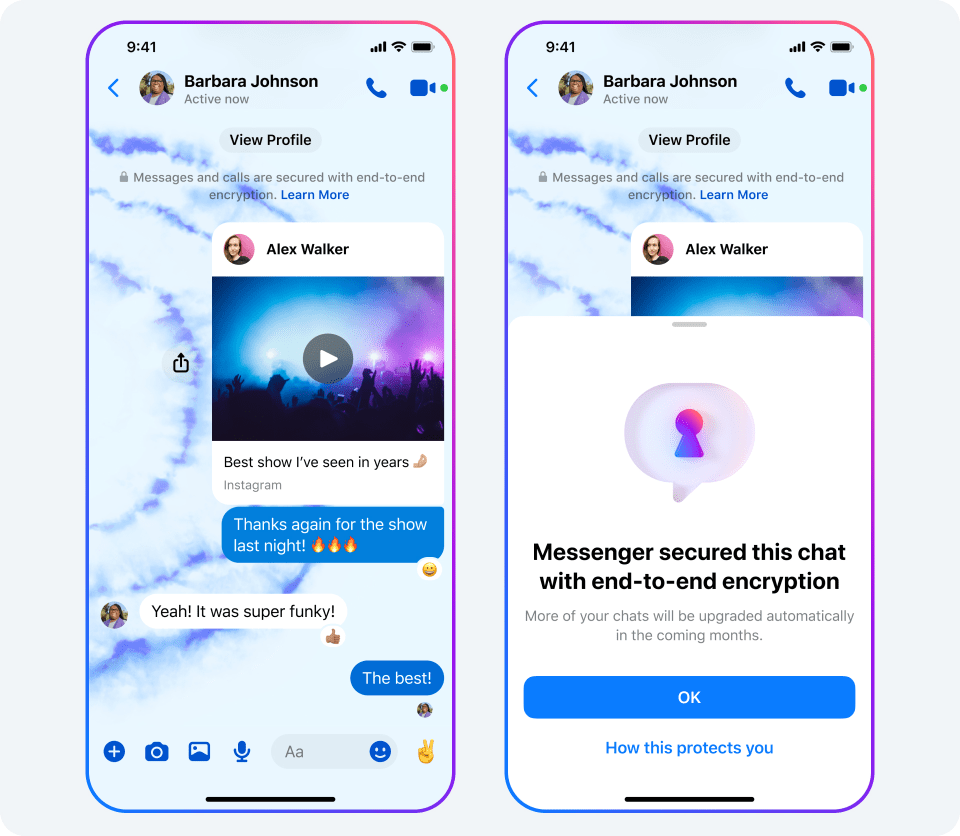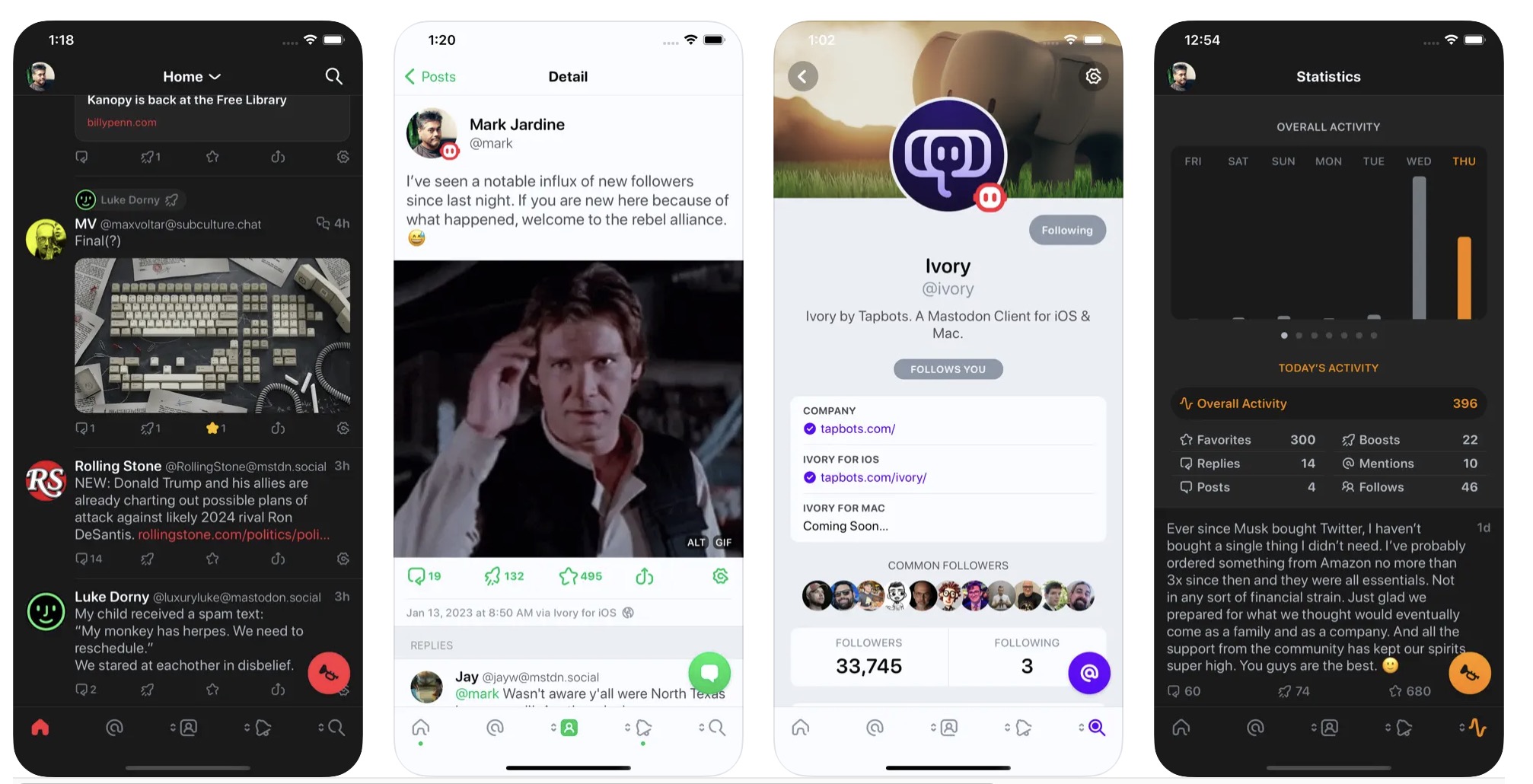
Where have you been, Randy? We've been waiting and waiting for you to take on the Weaker Speaker...
from Latest articles from Crooks and Liars
via Click me for Details

Where have you been, Randy? We've been waiting and waiting for you to take on the Weaker Speaker...
Welcome back to This Week in Apps, the weekly TechCrunch series that recaps the latest in mobile OS news, mobile applications and the overall app economy.
The app economy in 2023 hit a few snags, as consumer spending last year dropped for the first time by 2% to $167 billion, according to the latest “State of Mobile” report by data.ai (previously App Annie). However, downloads are continuing to grow, up 11% year-over-year in 2022 to reach 255 billion. Consumers are also spending more time in mobile apps than ever before. On Android devices alone, hours spent in 2022 grew 9%, reaching 4.1 trillion.
This Week in Apps offers a way to keep up with this fast-moving industry in one place with the latest from the world of apps, including news, updates, startup fundings, mergers and acquisitions, and much more.
Do you want This Week in Apps in your inbox every Saturday? Sign up here: techcrunch.com/newsletters

Image Credits: Temu
Temu, a shopping app from Chinese e-commerce giant Pinduoduo, has been having quite the run as the No. 1 app on the U.S. app stores. The mobile shopping app hit the top spot on the U.S. App Store in September and has continued to hold a highly ranked position in the months that followed, including as the No. 1 free app on Google Play since December 29, 2022. More recently, Temu once again snagged the No. 1 position on the iOS App Store on January 3 and hadn’t dropped since as of earlier this week.
Offering cheap factory-to-consumer goods, Temu provides access to a wide range of products, including fast fashion, and pushes users to share the app with friends in exchange for free products, which may account for some of its growth. The app has seen 5 million U.S. installs this January alone, up 19% from 4.2 million in the prior 22 days from December 10 through December 31, Sensor Tower says. This brings it to a total of 19 million lifetime installs across the App Store and Google Play, more than 18 million of which came from the U.S.
The growth now sees Temu outpacing rival Shein in terms of daily installs. In October, Temu was averaging around 43,000 daily installs in the U.S., the firm said, while Shein averaged about 62,000. In November, Temu’s average daily installs grew to 185,000 while Shein’s climbed to 70,000, and last month, Temu averaged 187,000 installs while Shein saw about 62,000.
The app appears to be leveraging a similar growth strategy to TikTok, which heavily spent on marketing to gain users. According to Meta’s ad library, Temu has run some 8,900 ads across Meta’s various platforms just this month. The ads promote Temu’s sales and its extremely discounted items, like $5 necklaces, $4 shirts and $13 shoes, among other deals. These ads appear to be working to boost Temu’s installs. But dig into the app’s reviews and you’ll find similar complaints to Wish, including scammy listings, damaged and delayed deliveries, incorrect orders and lack of customer service. Without addressing these issues, which helped bring down Wish, Temu seems more likely to go the way of Wish, not TikTok, no matter what it spends.

Image Credits: Screenshot of Walmart Text to Shop
Walmart recently introduced a new way to shop: via text. Last month, the retail giant launched its “Text to Shop” experience, which allows mobile consumers across both iOS and Android devices to text Walmart the items they want to purchase from either their local stores or Walmart.com, or easily reorder items for pickup, delivery or shipping. However, the chat experience as it stands today does not come across as fully baked, our tests found. The chatbot said confusing things and the user interface at times was difficult to navigate, despite aiming to be a simpler, text-based shopping experience.
We tested the experience, which leverages Apple’s Message app on iPhone, and it did not go well. The bot responded twice at times, offered only a few options for generic requests like “eggs,” asked everytime if an item was for pickup or delivery, provided inaccurate responses and spoke nonsense when confused — like when it returned options for “la croix organic eggs.” We’d say stick with the Walmart app for now.
Read the full review here.
Could the next big app platform be Apple’s AR/VR headset? That’s the news from Bloomberg, which leaked details of Apple’s upcoming headset, the $3,000 Reality Pro due out later this year. The headset will attempt to create a 3D version of Apple’s operating system, the report said, and will include features like FaceTime videoconferencing (with avatars), the ability to watch immersive videos, play VR games and use Apple’s apps — including the Safari web browser, photos, mail, messages, calendar, App TV+, Apple Music, Podcasts and the App Store.
The report described an interface with a grid of app icons and widgets, and said Siri could be used when you needed to input text. However, the interesting details involved how users could interact with on-screen items. Apparently, the device would have external sensors to analyze the user’s hands and sensors inside to track the user’s eyes. This would allow the user to select items on the screen by looking at them, then pinch their thumb and forefinger together to activate the task — without needing to hold additional hand controllers like rival headsets, Bloomberg said. It may also have its own Digital Crown, like Apple Watch, for switching between AR and VR and its iOS-like interface.
Additionally, Apple is reported to be building software that allows users, including those who don’t know how to code, to build their own AR apps for its upcoming mixed-reality headset.
There are of course still a lot of unanswered questions about the headset’s capabilities, though it does sound like a very “Apple” attempt at getting VR right. But the device’s price point will make it a premium product for the time being — and one launching during a down economy — which could limit its growth.
We want all versions of our games to use the current suite of Epic Online Services including parental controls, purchasing defaults, and parental verification features. We are not able to update the app on these platforms given Apple and Google’s restrictions on Fortnite. (2/2)
— Fortnite Status (@FortniteStatus) January 23, 2023

Image Credits: Bumble

Image Credits: Meta

Image Credits: Tapbots
Tapbots, the makers of the popular third-party Twitter app Tweetbot that was recently killed by Twitter’s API changes, this week publicly launched the company’s next new product. Hoping to fill the void that Tweetbot leaves behind, the company is now making its anticipated Mastodon client app Ivory available on the App Store as an Early Access release.
The “Early Access” label is a subtitle that Tapbots put on its release to indicate there will still be features missing as it debuts, the company told us. However, by launching publically on the App Store, Tapbots is able to put Ivory into more people’s hands after filling up the limited number of TestFlight slots it had for its test version.
For longtime Tweetbot users, Ivory will offer a familiar experience. But instead of serving as a client for Twitter’s network, the company has now embraced the promising open source platform Mastodon. Though not quite as simple to use or understand as Twitter, Mastodon has gained traction in the months following Elon Musk’s acquisition of Twitter.
At launch, it sports dozens of features, ranging from support for baseline functionality to clever bells and whistles, like being able to theme the app or change its icon.
The app also supports multiple accounts, and lets you view your local and federated timelines, trending posts, post statistics, notifications and more. It also enables Mastodon-specific options that weren’t available on Twitter — like the ability to add content warnings to posts — as well as more common features, like the ability to post GIFs and polls.
There are other thoughtful touches designed to appeal to power users, too, like hashtag tracking, mute filters with regex support and timeline filters that let you show or hide posts that meet certain criteria you set. This could appeal to Mastodon’s older users, as well, who may want to mute and avoid some of the posts shared by Mastodon newcomers who are bringing Twitter’s culture to the platform, leading to unwanted posts without content warnings in their timelines.

Image Credits: Pestle
Pestle, a handy and well-designed recipe app for iOS is getting a notable update on January 28. The app is adding a number of features for power users, including “Smart Folders,” which are automatically created folders that organize recipes based on user-set criteria, plus PDF and image import features. The latter allows users to import the recipes they had saved in other formats, while Smart Folders simplify the otherwise tedious process of organizing recipes. For instance, you could create Smart Folders that automatically add any saved recipe with a specific ingredient, or a dessert folder with additional rules. The app itself is a free download but offers subscriptions of $1.99/mo or $19.99/year (or $39.99 lifetime) for pro users.
This Week in Apps: Temu’s hot streak, Walmart’s m-commerce & an Apple XR App Store by Sarah Perez originally published on TechCrunch
Welcome to Startups Weekly, a nuanced take on this week’s startup news and trends by Senior Reporter and Equity co-host Natasha Mascarenhas. To get this in your inbox, subscribe here.
Sometimes, due to the nature of the startup game, we over index on “the new.” Companies want to build for the pain point you never dreamed to disrupt; VCs want to invest in an emerging trend before it becomes a household name; and those breaking into tech are told to lean into their earnestness, because you never know who is going to answer your cold email. In order for entrepreneurship to feel exciting and welcoming — not even be, but feel — new needs to be one of its loudest characteristics.
After all, you only get to be “it” once.
But one question I’ve found myself asking over the past year, especially as some of the more tenured folks speak about past downturns and cyclical learning lessons, is the latecomer advantage. It’s partially obvious: When you’ve done this whole entrepreneurship thing before, you understand what mistakes to avoid and seamlessly know which investors to dodge.
But it’s also partially not as easy of a story. There’s a difference between being new and being inexperienced, the same way there’s a difference between experienced and being late. How do you know where you are on that entire timeline — especially when the stories feel better to tell at the extremes?
This week on Equity, I interviewed T2 co-founder Sarah Oh, who is building a Twitter rival after working at Twitter as a human rights adviser. Quite quickly, I asked her how building a copycat of your former employer makes you feel. She seemed unbothered, to which I promptly said: All is fair in love and moderation.
But the better answer that Oh gave me was around the latecomer advantage that she has, building a company in a world that she knows extremely well. By joining the consumer social wave today versus before anyone even thought in characters and retweets, the co-founder thinks they get to factor in more of the nuance.
“There’s a lot that we know about gaps in trust and safety in the industry, whether it’s datasets that we need, or models that need to be built, or certain standards that need to exist for models, right, there’s a whole laundry list of things that I wish I had in my previous roles that just didn’t exist, we’re now at a place where we can have those conversations,” Oh said. She added that when some of the first social media platforms were being created, there weren’t “historical case studies or precedent” for a lot of the controversies that now exist. With some of the ugly out of the way — my words, not hers — T2 has examples it can refer back to on how to handle tensions around virality, doxxing and more.
It just made me think about that larger comprehension coupled with the nimbleness of a startup. Maybe, it’s being both old and new that might be the striking balance that helps a startup start up. In this case, we have no idea how the old or the new attempts at Twitter are going to do, but we do know that this time has never mattered more.
In the rest of this newsletter, we’ll talk about chief inspiration officers, growing startup accelerators and a rare buzz we’re hearing about one tech company and its public market wishes. As always, you can follow me on Twitter or Instagram.
Also on Equity this week, the crew spoke about how venture capitalists are going to pay more attention to how portfolio founders are spending capital — especially around hiring trends. Becca’s latest for TC+ — use code EQUITY for 50% off an annual membership — gets into why the hiring slide in the pitch deck is no longer going to be a throwaway part of the presentation.
Expect more scrutiny.
Here’s why this is important: We know that companies are dropping staff to cut costs, but those that are hiring may have to take a more conservative approach in both types of roles and level of pay. All to say, there’s definitely an opportunity to find talent if you are hiring. But, it won’t be easy for all laid-off talent to find their next gigs, especially as employers look to hire cheaper talent with less ambitious staffing goals.

Image Credits: MicroStockHub (opens in a new window) / Getty Images
NextView Ventures has launched its fourth accelerator program, aiming to back around half a dozen founders with $400,000 in funding and mentorship opportunities. It’s also offering at least one spot to a team built by ex-colleagues who have been laid off over the past downturn.
Here’s why this is important: The accelerator partners are open to backing founders even if they have a half-baked idea or only an area that they want to dig into. Even in a more disciplined market, there are some firms that are still comfortable seeding ideas versus fully fledged business ideas. “It’s almost half a step earlier than we’ve typically thought of” portfolio companies, Rob Go, founding partner, NextView Ventures, said, of the cohorts.

Image Credits: Talaj (opens in a new window) / Getty Images
Stripe is eyeing an exit, finally. The payments giant has set a 12-month deadline for itself to go public, either through a direct listing or pursuing a transaction on the private market, such as a fundraising event and a tender offer, according to sources familiar with the matter.
Here’s why this is important: I mean, must I state the obvious? The public markets for tech companies have been stale, unwelcoming, insert boring adjective here. If Stripe does kick off a trend, we’re in for an exciting next year. But some are dubious on the timeline. After all, it’s literally easier said than done.

Image Credits: masik0553 (opens in a new window) / Getty Images
Seen on TechCrunch
The thing we thought was happening with robotic investments is definitely happening
App downloads were stagnant in the fourth quarter, new analysis finds
Strava acquires Fatmap, a 3D mapping platform for the great outdoors
LastPass owner GoTo says hackers stole customers’ backups
Seen on TechCrunch+
The current legal cases against generative AI are just the beginning
A VC’s perspective on deep tech fundraising in Q1 2023
As activist investors target Salesforce, what’s next for the CRM giant?
Laid off from your crypto job? Here’s what founders are looking for in new talent
Startups should expect more scrutiny from VCs on their hiring plans
I’ll end with the evergreen reminder that I absolutely love going to startup happy hours and VC dinners in San Francisco, so do let me know if you’re throwing one! And if you’re still working on your social engine like me, I’m also always game to do a 1:1 coffee chat or dumpling lunch.
To the rest of you, thanks for reading as always. 2023 is already soaring on by, isn’t it?
Talk soon,
The latecomer advantage in startups by Natasha Mascarenhas originally published on TechCrunch
To get a roundup of TechCrunch’s biggest and most important stories delivered to your inbox every day at 3 p.m. PST, subscribe here.
Well, it’s Friday again. And as the Equity pod team noted today, “You could be Wasted and not even know it.” — Christine and Haje
Kano, the venture-backed U.K. startup known for its build-your-own computer kits and software for teaching coding and associated STEM skills, has accused Warner Bros. of copying one of its products and infringing on its intellectual property, Paul reports.
By any measure, Salesforce CEO Marc Benioff has been a successful executive. He helped build Salesforce from the ground up, starting in an apartment in San Francisco in 1999 and eventually erecting Salesforce Tower, the tallest building in the city, Ron reports. He took the idea of running software in the cloud and grew it into the de facto way to deliver software at a time when most companies offered software in boxes or on-prem seat licenses. As activist investors target Salesforce, what’s next for the CRM giant? (TC+)
And we have five more for you:

Image Credits: Luis Cagiao Photography (opens in a new window) / Getty Images
Forget about dogs: No-code development tools can be a nontechnical founder’s best friend.
Building a minimum viable product once required engineering and design ability. Now, bootstrapping founders can iterate without developers to keep costs and extend their runway.
“Instead of getting caught up trying to design the perfect and complete MVP release all at once, try to deliver value as quickly as possible and continuously improve your prototype,” advises Katherine Kostereva, CEO and managing partner of Creatio.
She shares four tactics for transforming prototypes into usable products via no-code:
Three more from the TC+ team:
TechCrunch+ is our membership program that helps founders and startup teams get ahead of the pack. You can sign up here. Use code “DC” for a 15% discount on an annual subscription!
Apparently, “AI that can generate art, text and more is in for a reckoning,” Kyle writes today. He’s been following a class-action lawsuit against Microsoft, GitHub and OpenAI that “accuses them of violating copyright law by allowing Copilot, a code-generating AI system trained on billions of lines of public code, to regurgitate licensed code snippets without providing credit.” Kyle lays it all out for you and even notes that cases like these against generative AI are just the beginning.
If you’ve been enjoying HBO’s new zombie thriller “The Last of Us,” you’ll be able to enjoy it a little longer. The show got picked up for a second season after delighting over 22 million viewers, Lauren writes.
Here’s your Friday five:
Daily Crunch: Stripe responds to report that it seeks to raise $2B with a terse ‘no comment’ by Christine Hall originally published on TechCrunch
Startups selling dev tools over the last few years have seen the pendulum swing. On one hand, developers rarely need anyone’s permission to start using their tools, which resulted in teams within the same organization using wildly different tech stacks. On the other, a growing number of companies are attempting to limit this chaos at the organizational level.
The latter trend is known as platform engineering and is embodied by platform engineering teams. Talking to TechCrunch, Boldstart Ventures partner Shomik Ghosh described these as “groups within typically larger organizations that are given the role to improve the developer experience for other developers in the organization.”
The Exchange explores startups, markets and money.
Read it every morning on TechCrunch+ or get The Exchange newsletter every Saturday.
The role of platform engineering teams includes coming up with their own tools and documentation, but also making buying decisions on core tooling that developers across their entire organization will be able to use.
For dev-centric startups, this presents a question: How do you sell your product to platform engineering teams?
We asked this and more to three people with deep knowledge of this space: startup founder Nora Jones, CEO at Jeli; Armon Dadgar, CEO and co-founder of NASDAQ-listed company HashiCorp; and Draft.dev CEO Karl Hughes, a developer content marketing expert. Let’s dive in.
What does selling to platform engineering teams mean for developer relations? by Anna Heim originally published on TechCrunch
In late April, police in Nebraska received a tip saying 17-year-old Celeste Burgess had given birth to a stillborn baby and buried the body. Officers soon learned that her mother, Jessica Burgess, and a friend had helped her with transportation and burial. The police issued citations for concealing the death of another person and false reporting. But in June, they also charged Jessica with providing an abortion for her teenage daughter. Police had made the discovery after obtaining a warrant that required Meta to hand over their conversations on Facebook Messenger. The messages, which were not encrypted, showed the two had discussed obtaining and using abortion pills.
Warrants for digital data are routine in police investigations, which makes sense given how much time we spend online. Technology giants have for years responded to valid court orders for specific information sought by law enforcement, though some companies have done more to fight for our privacy than others. Millions of people now use apps that encrypt their calls and messages, like Signal and WhatsApp, so that no one can access their messages — not even the providers themselves.
The case in Nebraska is not the first in which police have used digital data to prosecute an abortion, and it won’t be the last. While digital data is rarely the main form of evidence, prosecutors use it to paint a picture in court; by showing messages sent to friends, internet searches, or emails from an online pharmacy. As in the Burgess case, however, it’s often people around the women who first notify the authorities — a doctor or nurse, a family member, or a friend of a friend.
When the U.S. Supreme Court overturned Roe v. Wade last summer, it ended the constitutional right to abortion. In doing so, it gave states the power to regulate abortion or ban the procedure altogether, triggering a wave of abortion bans nationwide. At least 13 states now ban abortion with few or no exceptions. Georgia recently reinstated a ban after six weeks of pregnancy. And in many states, the fight over abortion access is still taking place in courtrooms.
A week after the ruling, Google announced it would delete location data for visits to abortion clinics and other medical facilities. The Electronic Frontier Foundation said we should review our privacy settings. The Digital Defense Fund encouraged us to use encrypted messaging apps. Some suggested that we delete our period tracking apps. It may seem odd to dedicate so much attention to digital privacy in the context of our reproductive rights. But a look at prosecutions between 2011 and 2022 illustrates why these conversations are needed.
—
In May 2011, police in Idaho charged Jennie McCormack with inducing her own abortion. The 32-year-old couldn’t afford a legal procedure. Instead, she took pills purchased online. NPR reported that McCormack confided in a friend shortly after the abortion. It was this friend’s sister who told the police. When officers arrived at her home, they found the fetus wrapped up on her back porch.
McCormack admitted to the police that she self-induced an abortion after ingesting a pack of five pills. At trial, she told the court that the medication was “FDA-approved,” “procured through the internet,” and “prescribed by a physician.” Years later, an appeals court noted that “McCormack’s sister allegedly found unspecified abortion pills online, paid $200 for them, and had them shipped to McCormack in Idaho.”
At the time, McCormack faced up to five years in prison. The case was eventually dismissed.
—
In March 2015, Indiana sentenced Purvi Patel to 20 years in prison for neglect of a dependent and feticide. Two years earlier, Patel had gone to the hospital with bleeding after delivering a child at home. She first told the medical staff that she had been ten to twelve weeks pregnant. But when questioned by two doctors, admitted to giving birth and said the baby was stillborn.
Patel told the doctors she had put the body in a paper bag and placed it in a dumpster behind a Target store, not far from her family’s restaurant. The hospital notified the police, who searched the area and recovered the bag. A doctor who participated in the search said “the baby was cold and lifeless” but “was an otherwise normal, healthy appearing baby.”
Court documents show that police obtained a search warrant for Patel’s phone. An officer with “training in examining electronic devices” downloaded her text messages. In reviewing the data, the police found that she had discussed her abortion with “at least one friend.” Patel had also shared that she’d obtained and taken abortion pills from Hong Kong.
An Indiana appeals court overturned the feticide conviction in July 2016. The court noted that in searching Patel’s iPad, “police found a customer service email from InternationalDrugMart.com.” The email confirmed that Patel had ordered mifepristone and misoprostol for $72. A detective ordered the same pills, presumably to confirm that it was possible to do so. Police also found Patel had visited a website titled “Abortion after Twelve Weeks.”
The court documents do not mention the type of phone Patel had or how police gained access to her messages. But the messages were at least three months old, suggesting that she likely did not delete the texts or the email from the online pharmacy.
Indiana’s attorney general decided not to appeal the court’s ruling. In September 2016, Patel was resentenced to 18 months for child neglect, less time than she had already served. The judge then ordered Patel’s immediate release.
—
In April 2015, police in Arkansas arrested Anne Bynum after she gave birth to a stillborn child at home. She was charged with concealing birth and abuse of a corpse. The state also charged her friend, Karen Collins, with performing an abortion.
Bynum, who already had one child and worked a minimum-wage job, never told her parents about the pregnancy. When her pregnancy became difficult to hide, she took medications to induce labor.
In a video interview, Bynum said she delivered the baby at home by herself, in the middle of the night. “She was just beautiful. Really beautiful. But eyes closed, mouth closed. Complete stillness.” Bynum wrapped up the remains and went to bed. The next day, she drove to the emergency room with the remains in the front passenger seat. Bynum said she “gave birth last night, but she didn’t make it.” Medical staff determined it had been a stillbirth.
When the hospital discharged Bynum days later, she was arrested on her way home. The sheriff put her in handcuffs and placed her in the back of the police car. Bynum’s trial was brief, just two days of testimony and a few minutes of jury deliberation. The judge sentenced her to six years in prison. An appeals court reversed the conviction in December 2018.
Exactly who notified the police remains unknown. The appeals court noted that “Bynum told friends, her attorneys, and her priest about the pregnancy and of her intent to put the child up for adoption when it was born.” On the morning after she gave birth, Bynum texted her attorney “who advised her to go see a doctor.” The attorney also called a funeral home and “was advised to have Bynum take the fetal remains to the hospital.”
It’s unclear whether Bynum shared the texts herself, or if police recovered them another way.
—
In January 2018, Mississippi charged Latice Fisher with murder for the death of her newborn the year before. The Washington Post reported that when paramedics arrived at her home, they found “a baby in the toilet, lifeless and blue, the umbilical cord still attached.” The baby was pronounced dead at the hospital. Fisher initially said she didn’t know she was pregnant, but later admitted that she had been aware of the pregnancy for at least a month. She also admitted to conducting internet searches for how to have a miscarriage.
Fisher reportedly “voluntarily surrendered” her iPhone to police. Court records show her phone’s “memory and data were then downloaded, including but not limited to Fisher’s past internet activity.” While reviewing that data, investigators learned that Fisher had researched “buy abortion pills, mifeprisone [sic] online, misoprostol online,” and “buy Misoprostol Abortion Pill Online.” Fisher had also “apparently purchased misoprostol immediately subsequent to these searches.” Another court document suggests police also searched her husband’s phone.
While there is no evidence that Fisher took the pills, prosecutors used her digital data to argue that she intended to abort her pregnancy. The murder charge was eventually dismissed.
—
Technology companies may not have many options for handling search warrants from the police, even when the investigations relate to abortion. But companies do get to decide how much digital data they collect about people and for how long they store the information. They also get to decide whether to offer end-to-end encryption, which would give people increased privacy for all of their messages. Following Russia’s invasion of Ukraine last year, Meta announced it’s making encrypted one-to-one chats in Instagram available to adults in the two countries. And while Elon Musk said Twitter should end-to-end encrypt direct messages prior to acquiring the company, it’s unclear if this will actually happen.
Last year, reporters found that Facebook and anti-abortion clinics collect sensitive information on would-be patients. The Markup also reported that Hey Jane, an online abortion pill provider, employed a series of online trackers that follow users across the internet — until the journalists reached out about the practice. More recently, ProPublica found nine pharmacies selling abortion pills also sharing sensitive data with Google and other third-parties. All nine were recommended by Plan C, which provides information about how to get abortion pills by mail. None responded to ProPublica’s request for comment.
In Abortion, Every Day, publisher Jessica Valenti reminds us that “if you are white, have money, and the ability to travel to a state where abortion is legal — you will have a much easier time than those from marginalized communities.” Everybody deserves access to reproductive health care. If the past decade is any indication, protecting essential abortion rights is going to require all of us, from doctors, nurses and attorneys to lawmakers, software engineers and voters.
Sarah Mitchell-Weed contributed research.
How US police use digital data to prosecute abortions by Zack Whittaker originally published on TechCrunch

During a debate over "Oil & Natural Gas Drilling on Federal Land" on the House floor earlier today, Rep. Ted Lieu got to the heart of the issue angering Republicans.
"I can summarize this debate of the last two days into one sentence. Joe Biden lowered your gas prices, and Republicans are upset about it," Rep. Lieu said. "That's what this is about. Joe Biden lowered the gas prices last year, and that makes Republicans mad."
"How do we know? They said it out loud. The gentlewoman from Georgia earlier this morning just said that Joe Biden lowered your gas prices for political reasons," he said. "I don't care why the president lowers your gas prices. If any president can lower your gas prices, we should support that president's action."
Rep. Lieu's words were also in response to Marjorie Taylor Greene's Oil Reserve amendment that went down in flames yesterday with an embarrassingly bad vote for the Georgia Congresswoman.